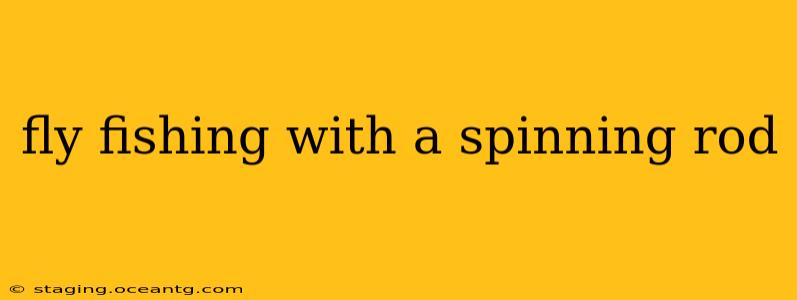Fly fishing, with its delicate presentations and elegant movements, is often associated with specialized fly rods and reels. However, a surprising number of anglers are finding success using spinning rods for fly fishing, particularly in specific situations. While not a direct replacement for a traditional fly rod setup, understanding the nuances of this unconventional technique can open up new possibilities and expand your angling horizons. This article will delve into the intricacies of fly fishing with a spinning rod, addressing common questions and highlighting its advantages and disadvantages.
Why Would You Fly Fish with a Spinning Rod?
This might seem counterintuitive at first glance, but several scenarios make a spinning rod a viable, even preferable, option for fly fishing:
- Accessibility and Cost: Spinning gear is generally more affordable and readily available than fly fishing equipment. This makes it an excellent entry point for beginners curious about fly fishing without the significant initial investment.
- Casting in Windy Conditions: Strong winds can significantly hinder fly casting with a traditional fly rod. The heavier line and rod of a spinning setup provide more power and control, making it easier to cast into headwinds.
- Targeting Specific Species: Certain species, particularly those that are less finicky about presentation, can be successfully targeted with a spinning rod and small flies. Think smaller panfish or even some opportunistic trout.
- Reach and Distance: For anglers fishing from long distances – say, across a wide river or lake – the longer casts achievable with a spinning rod can be advantageous.
- Versatile Tackle: You can switch easily between lures and flies, providing more options based on the fish activity.
What Kind of Spinning Rod and Reel Should I Use?
Choosing the right spinning gear for fly fishing requires careful consideration. You’ll want a rod that's more flexible than a typical bass or saltwater spinning rod. Look for:
- Medium-Light to Medium Power: This range provides enough backbone to cast effectively but retains the sensitivity needed to detect subtle strikes.
- Fast Action: A fast action blank will help in making accurate casts and delivering the fly properly.
- Length: A 6- to 7-foot rod is generally suitable for most situations.
- Reel: A reel with a smooth drag is essential for handling unexpected runs. A 2500-3000 size reel is usually sufficient.
What Line and Flies Should I Use?
The line and flies you use are critical for success. Here's what you should keep in mind:
- Line: Using a relatively light monofilament or fluorocarbon line (4-8 lb test) is typically best. This will allow for a delicate presentation while still providing enough strength to handle fish.
- Flies: Smaller flies tend to work better than larger ones. Select patterns that are appropriate for the species you are targeting and the conditions. Dry flies, nymphs, and even small streamers can all be successfully fished with this setup.
How Do I Cast a Fly with a Spinning Rod?
The casting technique is different from traditional fly casting. Instead of using the overhead roll cast, you will employ a more conventional spinning rod casting style. Practice your casting technique to ensure your fly lands gently on the water. Accuracy is key.
What are the Disadvantages of Fly Fishing with a Spinning Rod?
While effective in certain situations, this technique has limitations:
- Presentation: It's difficult to achieve the same delicate and subtle presentations as with a traditional fly rod.
- Drag: The line drag from a spinning reel can sometimes be too significant, impacting the overall presentation and spooking fish.
- Technique: It requires practice and adjustment to master the casting and retrieval techniques.
Is Fly Fishing with a Spinning Rod Cheating?
This is a matter of opinion and ethics. Some purists may consider it to be outside the spirit of traditional fly fishing. However, many anglers see it as a fun and effective way to catch fish, particularly when dealing with specific challenges such as wind or limited access. The most important thing is to fish responsibly and ethically.
Conclusion
Fly fishing with a spinning rod is an unconventional but viable approach, particularly for beginners, anglers on a budget, or those tackling challenging environmental conditions. While it won't replicate the finesse of a traditional setup, understanding its advantages and limitations can open up new opportunities for fishing success. Remember to practice your casting, choose the right gear, and always respect the environment and the spirit of responsible angling.
